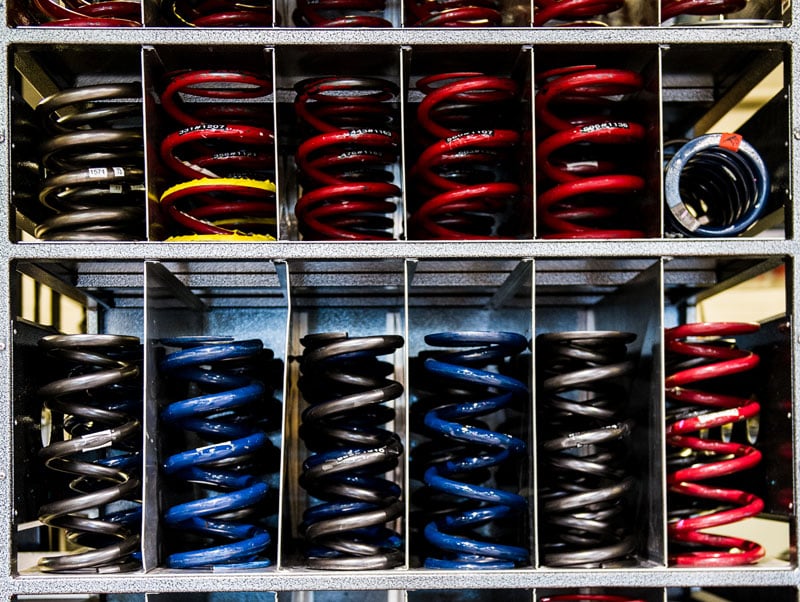Spring Rate or Damping? How to Stiffen Rear Suspension Properly

October 18, 2021

What’s more important to you, speed or comfort?
For most drivers, it’s somewhere in the middle.
With the stock suspension, manufacturers are trying to reach a large market. Most vehicles will be set up to perform pretty well but also be super comfortable.
However, if you want outstanding performance, especially on the track, you might want to invest in double-adjustable shocks and then stiffen your suspension. Although you may be less comfortable, your vehicle will feel more agile, nimble, and ultimately handle better. Or so goes the theory.
How Do You Stiffen Rear Suspension?
When considering the stiffness of your suspension, understand it’s a highly iterative process. You’ll need to test and retest to make sure you’re improving how your vehicle handles.
Check out our FREE DOWNLOAD: Shock Build and Shock Setup/Lap Time Worksheet
In this free download, we provide both our Standard Shock Build Sheet, which is a great way to keep all your shock builds organized, and a Setup/Lap Time Sheet, a great tool to help improve your communication and record keeping of your chassis setup.
While stiffer suspension can give you an edge, going too far can be detrimental. You need to factor in ride quality and decide if stiffer shocks are better for your performance or not. This will depend on your application, how often you race, and external factors such as rough or smooth tracks, weather changes, and your driving style.
That being said, let’s look at how to stiffen rear suspension properly and the effects doing so will have.
Spring Rates
Springs are one of the most crucial parts of your suspension setup. They determine how close or far your chassis sits from the road or track. Adjusting the springs helps prevent bottoming out, limiting body roll when accelerating and cornering, and limiting nose-diving when braking. They are pretty important in determining how your car handles.
Over a bump, the spring compresses, absorbing the force, and then rebounds to release the energy. The spring compresses and rebounds at a precise rate in an ideal scenario, so you barely feel it.
Spring rate refers to the force exerted when a given amount compresses the spring. The rate of your spring could be 200 lb/in. If you compress the spring by 1 inch, it will exert a force of 200 lbs back.
Changing Spring Rates
Changing spring rates to level up your performance will come down to a few factors. Spring rates are personal and depend on your application, height and weight, driving style, and even differences in track surfaces.
Higher Spring Rates
Higher spring rates will give you a firmer feel, and many racecar drivers tend to prefer stiffer springs to reduce body roll and body lean. They also want low ground clearance to maintain a low center of gravity. On smooth tracks, they don’t need to worry about bottoming out and damaging the chassis.
Aerodynamically speaking, less air passes under the vehicle with low ground clearance, keeping it close to the track.
Downforce also comes into play. When downforce presses down on your vehicle, it could alter ride height. If you want your car to stay at a similar ride height, stiffer springs will act against those forces.
If springs are too stiff, ride quality will suffer, and your tires won’t be able to do their job correctly on bumpy and uneven roads.
Lower Spring Rates
Lower spring rates will provide you with a softer feel, but you get more grip. When going over a bump or curb, softer springs will maintain contact with the road better than stiffer springs.
Engineering is very black and white. Only you will be able to determine whether you want your shock and springs to be stiff or soft. You might feel your car handles better when the suspension is softer. Don’t just go by what you think you should be doing.
Damping
Shocks have a primary job: to control the speed at which your wheels move up and down. They perform this job by stopping your springs from compressing and rebounding too quickly. Controlling these variables allows for a better driving experience.
You can adjust the damping force or rate of your shock when it tries to compress and when it rebounds.
Stiffer shock rates slow spring movements, while a softer shock rate allows the spring to move faster. If a shock is too stiff, it can cause the tire contact patch to bounce off the road surface over bumps, making your car or bike feel less predictable. If this is happening, you’ll need to soften your shocks.
However, too soft shocks will make the body of your car or bike bounce after hitting a bump or rut. It’s essential to find the middle ground between comfort and performance, but it’s not cut and dry. You need a highly adjustable shock. You’ll need to take baseline measurements, and you’ll need to test and retest incrementally.
Want to learn more? Check out How to Adjust Low and High-Speed Damping to Optimize Shock Performance and What is the Difference Between Low-Speed Damping and High-Speed Damping?
A Team Effort
Springs and dampers work together, so it’s essential to give equal care and attention to both.
When springs are compressed, they store energy, and when they rebound, they release that energy. If your vehicle only had springs, the energy wouldn’t have anywhere to go, and you would just bounce up and down the entire time.
Springs support your car or bike’s weight and absorb or damp the various shocks generated from road friction, and ensure the wheels track the road’s surface as it changes.
Shocks dissipate the stored energy and control the speed at which your springs move up and down by stopping them from compressing or rebounding too quickly.
Adjusting both will bring the best results.
Preload Adjustment
We also need to mention preload adjustment.
Preload allows you to compress the springs when the shocks are fully extended, hence preload compression. Using the example of 200 lb/in: if you turned the preload adjuster and added 1 inch of mechanical compression, the spring would exert 200 lbs back. To compress it further, you’d need to apply more than 200 lbs of force.
The rate remains the same, but by adding preload, you change how the spring reacts to the weight applied to it when you brake, accelerate, and take corners.
Check out our ON-DEMAND WEBINAR: Top 10 Most Common Suspension Issues & How to Resolve Them
In this free webinar, we review the most common suspension issues you're likely to encounter and tips for how you can resolve or avoid them altogether.
Should You Stiffen Your Rear Suspension?
As with many adjustments and modifications to your vehicle, it depends. While stiffer suspension might increase driver sensitivity, improve handling response, and improve tire contact on smooth roads, conversely, it can decrease ride quality, handling performance, and grip on bumpy roads.
To help you decide whether you should stiffen your rear suspension or not, we talk about it in-depth here.
Whether it leads to a better performance depends on your application.
Let the Experts Help
Penske Racing Shocks are committed to providing you with shocks that meet the highest standards and focus on optimizing your setup before you even buy anything. Continued support after purchase ensures that you can make adjustments with confidence. To learn more about the process, sign up here.


%20(1).png?width=1080&height=1080&name=Heritage%20Cruiser%20Shock%20-%20IG%20(1)%20(1).png)